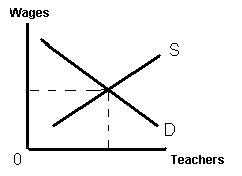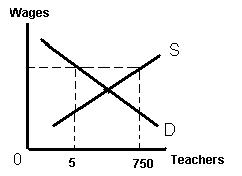Many tried to justify their position that teachers are underpaid by reversing the suppliers and consumers of teaching services. These students argued that the 750 applicants for 5 positions did not represent a surplus supply of teachers but, rather, a high demand for teaching positions. In this view school districts, rather than being buyers of teaching services are really providers of jobs for teachers. Of course, if this was the case, teachers would have to buy their jobs.*
Jobs are NOT an entitlement. Jobs exist solely because a producer reaches a point where he/she is unable to increase by their own efforts. At this point the producer hires others to provide the help needed to produce the additional output.
Parents want their children educated so an individual with the skills and knowledge to teach offers her teaching services for a fee. This person is successful but discovers that there are both more children to be taught and that the parents want, and are willing to pay for, more in depth teaching of various subjects. Rather than continuing to spend all day teaching a broad range of subjects to one group of thirty students, this entrepreneur hires additional teachers to specialize in various subjects. She is now able to rotate the students among different teachers for more in depth education in specific subjects and handle more than thirty students per day. She is meeting the needs of more consumers and making more money as a result of hiring the additional teachers. But note that she hired the additional teachers not because they needed a job or wanted to teach but because she needed their labor services to expand her business. Large businesses, including public school districts, differ from the entrepreneur/teacher above only in size.
Wages for teachers, or anyone else, are determined by market forces of supply and demand. Schools need teachers and a demand curve can be constructed showing what quantity of teaching services (or number of teachers) they are willing and able to hire at various prices (wage rates). Similarly, there is a pool of people with the skills and desire to teach. Like all workers, teachers, with their skills, have other job opportunities besides teaching so a supply curve can be constructed showing the various wages (prices paid for teaching services) and the corresponding number of teachers available at these various prices. The actual wage for any worker in competitive market is determined by the intersection of supply and demand.

Market Supply and Demand for Teachers (equilibrium wage and equilibrium number of teaching positions)
When wages are set at a rate above the intersection of supply and demand there will be a surplus of people seeking positions. In the graph below note that at the current wage rate, which is above the equilibrium wage, the demand for new teachers is 5 while the supply of those available at that wage is 750. Note also that the 5 positions at the present wage rate is considerably LESS than the number of positions available at the market wage rate.

Situation where wage set above equilibrium wage level.
Proponents of increased spending on education argue that it is needed in part to enable schools to hire more teachers thereby decreasing the pupil to teacher ratio (i.e., smaller class sizes) and improving the quality of education. However, as shown in the graph above, the same could be accomplished by allowing teachers' wages to fall to market equilibrium levels. Allowing teachers' wages to fall to equilibrium levels would also result in an increase in the number of teaching jobs and this would eliminate part of the surplus of unemployed teachers. The remainder of the teacher surplus would disappear as those at the margin (i.e., those attracted to the profession because of the above market wage) saw teaching wages drop below the wages in alternative professions these people are equipped to enter. In this sense, the current above market wages are unfair to college students because they are encouraging these students to invest time and money in preparing for a profession that already has more trained professionals than it has jobs available. The losers in this situation, where we let market forces determine teacher wages, would be those currently working in the profession who would see their incomes decline.**
Today there exists both a SHORTAGE and a SURPLUS of K-12 teachers. Both are the result of K-12 education being provided primarily by the government rather than the private market and pay scales determined by political rather than market forces. The teacher SHORTAGE in general is limited to the areas of science and math while the SURPLUS is in the other subject areas. People trained in science or math are in HIGH demand by industry while people trained in areas like history face a much LOWER demand. If teacher salaries were set solely by market forces, science and math teachers would receive higher wages than teachers in areas like history.
Under the present teacher compensation system, all teachers within a district are paid according to the same scale regardless of subject. The scale is usually a compromise between the HIGHER wage needed to attract science and math teachers and the LOWER wage needed to attract teachers in other areas. This compromise results in a wage that is BELOW equilibrium for science and math teachers and ABOVE equilibrium for teachers of other subjects. Thus, those with a degree in science or math who want to teach have no problem finding a job right out of college while those with degrees in other subjects are often forced to accept jobs as substitute teachers, lower paying jobs in schools run by churches and other non-profits, part-time tutors or similar work for long periods as they continue to try to land one of the coveted positions, with above market pay, in their subject area.
*NOTE: This is not quite as far fetched as it sounds. In the eighteenth and early nineteenth centuries officer positions in England's army and the Royal Navy were sold to the highest bidder. Aristocratic parents (as well as wealthy merchants who sought to advance their sons socially) would purchase an appropriate military rank for their younger sons (the family titles and lands went, by law, to the oldest son). This gave the son both the status of the rank and the income (from the government) associated with the rank. When the holder of the commission was ready to either purchase a higher rank or retire he would sell the current commission to another.
**NOTE: Existing contracts and a need to maintain both morale and prevent the chaos resulting from the mass resignation of existing teachers would temporarily shelter existing teachers from direct cuts in pay. More than likely such a change would follow a path used by airlines and other industries needing to make substantial cuts in wages. In the case of airlines existing pilots maintained their present wages and many, but not all of their benefits and perks, while new pilots were hired at much lower wages and far fewer benefits and perks. In addition to the dual wage structure, the airlines severely restricted increases in wages and benefits for the existing pilots and, in some cases began to reduce benefits.





No comments:
Post a Comment